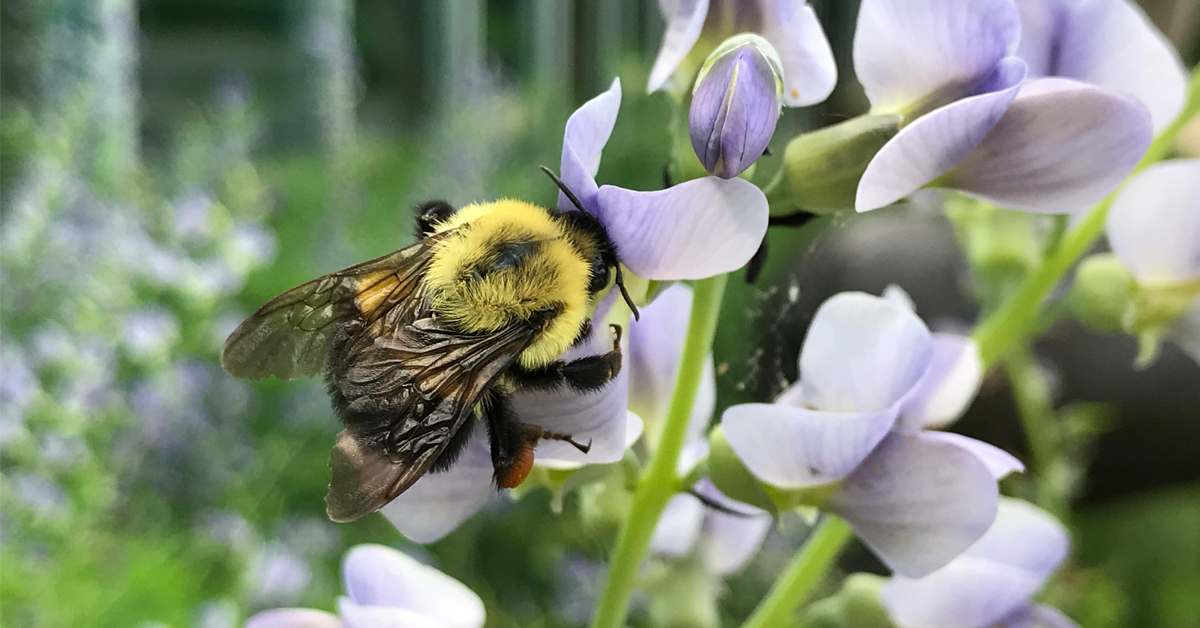
Common Eastern Bumblebee on native blue wild indigo (Baptisia australis). As pollen sticks to its body, the bee uses comb-like hairs on the inside of its legs to brush the pollen food into basket-like structures, called corbiculae, located on the outside of its legs. A full basket, seen here as a dark orange clump, can contain as many as 1 million pollen grains, which are then taken back to the nest.
By Carol A. Heiser/DWR
Photos by Carol A. Heiser
On a hot summer day, a juicy peach or a slice of watermelon or a bowl filled with a colorful mix of blueberries, cherries, kiwi and mango can sure be a refreshing pick-me-up. We probably give scarcely a second thought to nature’s role in providing the bounty on our table. Yet the variety and abundance of insect species that are required to pollinate the plants that produce these and the many other fruits and vegetables we eat is truly amazing. If you enjoy tomato on your sandwich, honey in your tea, apple pie at a picnic, or strawberries on your cheesecake, thank a bee!
Pollination: the Ultimate Ecological Service
Pollination is the process of transporting pollen from the male part of a flower to the female part, resulting in fertilization that leads to seed or fruit production. Bees, especially native, wild bees, are the most important insect pollinators, joined by beetles, flies, moths, butterflies, birds, bats, and other mammals. Although some plants are wind-pollinated—like conifers, ragweeds, and grasses such as corn and cereal crops—animal pollination is responsible for up to 90 percent of flowering plant reproduction, which includes 87 out of 128 of the most important global food crops we depend on.
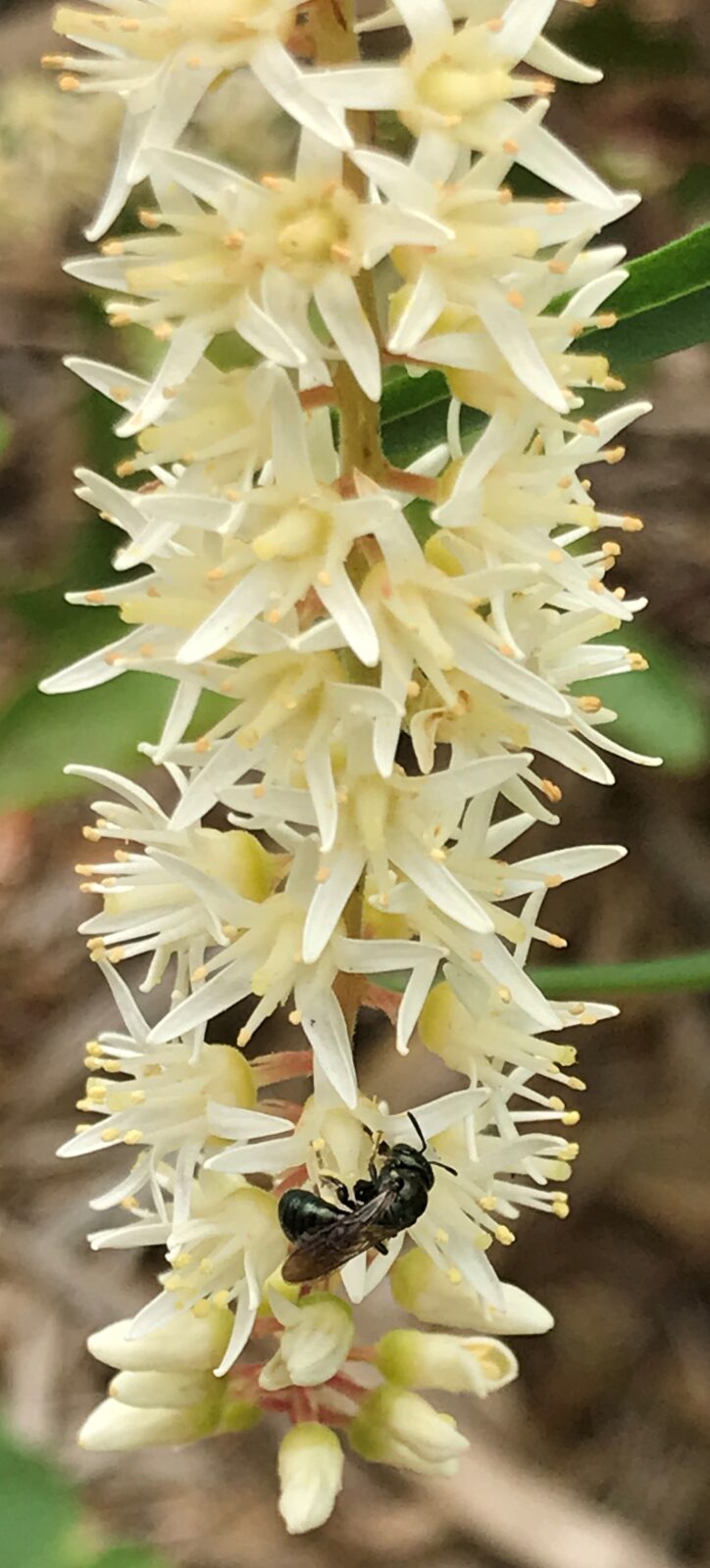
Humans aren’t the only ones relying on pollinators to generate the food we need, though. The health and continuity of natural ecosystems is also heavily dependent on pollination services. Pollinators are ecological keystone species, because they support the vast majority of terrestrial plants around the world that form the basis of innumerable food webs, which sustain the survival of all life, including our own.
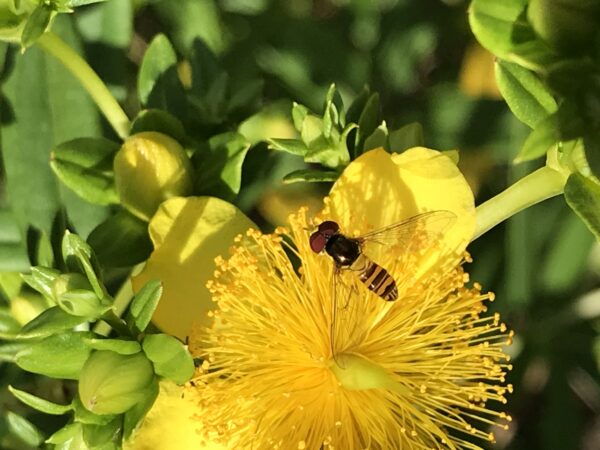
Hoverflies, also known as flower flies or Syrphid flies, are bee mimics that do not sting. Adults feed on pollen and nectar, like that of this St. John’s Wort flower (Hypericum spp.), while their larvae are excellent predators of aphids and other small insects.
Flower and Insect Specialization
Plant communities have co-evolved with animal communities. Over the course of natural selection, plants have developed highly specialized flower structures or characteristics that enable only pollinators with a corresponding specialization to actually move pollen from the anthers, the male reproductive part of a flower, to the stigma, the female part of the same flower or of another flower. When the transfer occurs between different flowers, called cross-pollination, the result is greater genetic diversity across the plant population. Greater diversity makes it more likely that a plant population will be able to adapt to and survive environmental changes.
Plants exhibit a wide variety of flowering traits that attract pollinators for different reasons, such as the shape, size, color or odor of the flower, the amount of nectar or pollen it produces, or the timing of the floral display.
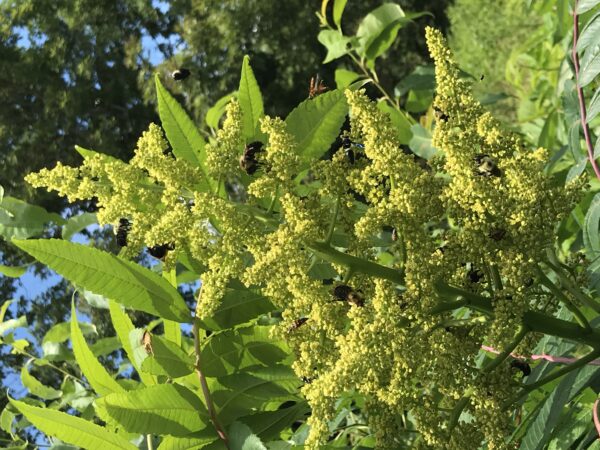
A sumac in full flower is a magnet for bees, wasps and beetles.
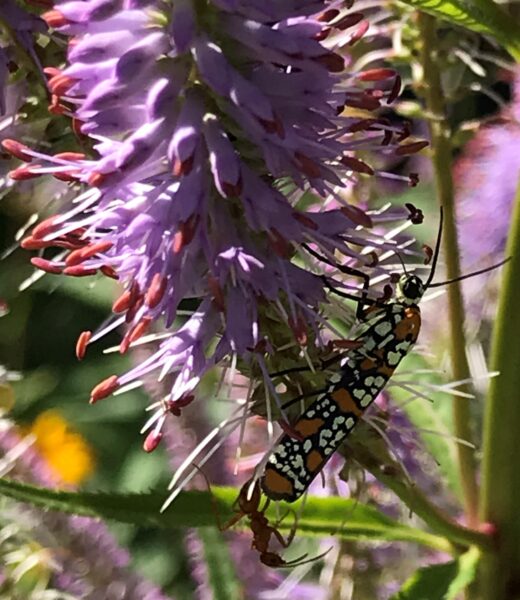
A native ermine moth, called the Ailanthus webworm moth, visits a Culver’s-root flower (Veronicastrum virginicum), and an ant tags along. The caterpillars of this moth eat the leaves of young Ailanthus trees, an invasive exotic species.
Bees eat only nectar and pollen, and many bees are specialists on a host plant, with some bees requiring a particular kind of pollen to reproduce. Almost 30 percent of the native bees in the mid-Atlantic region are pollen specialists, and as many as 70 percent of the more than 700 bees in the eastern U.S. are specialists.
However, while many insects may visit a flower to seek pollen for protein or to obtain nectar for sugar, not all of them are responsible for pollination.
True Pollinators
Rather, it’s the insects uniquely adapted for particular flower traits that are likely to be true pollinators, whether by virtue of a physiological adaptation or a behavioral one. For example, the sticky pollen of some plant species may be presented on a flat, disc-like flower, whose shallow landing platform makes it more likely that the pollen from the anther will stick to the hair of a bee’s abdomen or legs as the insect walks around and brushes against it.
In contrast, other plant species have tubular-shaped anthers with only a small opening on the tip, or a series of small, narrow slits along the sides of the tube that will allow the pollen out, a specialization that keeps the pollen grains packed tightly within and makes it difficult for small insects to access. This has an evolutionary advantage of minimizing the amount of energy that might be lost in producing excess pollen that wouldn’t arrive at the necessary destination.
Such flowers require “buzz pollination,” and bumblebees and several other native bee species are very efficient at this task. As the bee explores in and around the flower, it rapidly moves its flight muscles, which causes its wings and body to vibrate at a specific frequency and effectively dislodge and release the pollen through the anther’s opening or slits. The powdery pollen then shakes onto the bee and sticks to its hairs. Tomato production is greatly enhanced when buzz pollination occurs by native bees (the non-native honeybee does not visit tomato flowers).
An ecologist at Mary Baldwin University, Dr. Mary Jane Epps, has observed another interesting pollination phenomenon on native azaleas (Rhododenron spp.), such as flame azaleas (R. calendulaceum), a shrub that’s native to the higher elevations of southwestern Virginia. The bright orange or yellow flowers on this plant have anthers that extend way beyond the end of the flower, too far out for bees to pick up the pollen on their bodies when probing down into the funnel. How native azaleas are pollinated was a mystery, until Dr. Epps’ discovery that a butterfly’s wings are responsible.
As a butterfly nectars on the flowers, its flapping wings tap the anthers and release chains of pollen that stick to the wings. The pollen is then transferred with more wingbeats onto the female part of the flower. Tiger swallowtails apparently flap their wings at a greater rate than other butterfly species and thereby seem to be most effective at the pollen transfer.
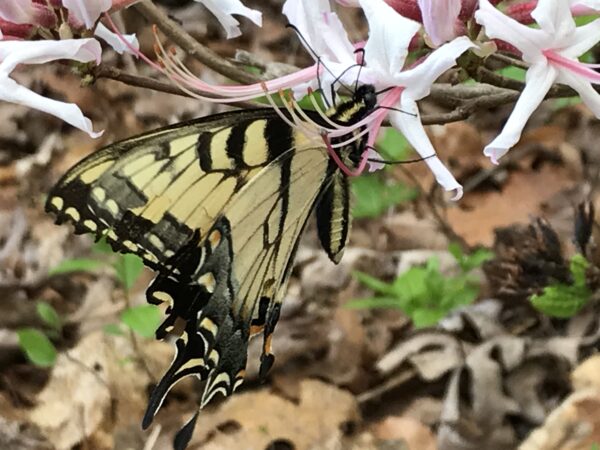
An eastern tiger swallowtail probes for nectar with its tubular mouthpart, called a proboscis, in a native pinxterbloom azalea (Rhododendron periclymenoides). The long stamens of the flower hold their pollen at the very tip, in the anthers at the end of each filament, an adaptation that makes it more likely butterfly wings will brush against them.
The deeply tubular flowers of a trumpet honeysuckle require the long tongue of a sphinx moth to access the necessary parts of the plant.
Beetles, on the other hand, are attracted primarily to the scent of flowers, such as the sweet smell of large, singular, bowl-shaped magnolia flowers, or the small flower clusters of goldenrod, or the spicy scent of flowering crab apple, spicebush and sweetshrub.
Threats to Pollinators
Sadly, much of the investigative research on pollinators over the past several decades continues to show a steady decrease in many native bee populations and some butterfly populations as well, such as the monarch. As habitat is degraded or displaced by land use practices and landscape management that reduces overall vegetative diversity, the ranges of different bee species have gradually contracted or shifted accordingly, in response to the changes. Environmental pressures on pollinators—indeed on most wildlife—include the reduction of natural areas and depletion of diverse floral resources and nesting areas, the broad use of pesticides, and climatic factors that contribute to temperature changes and associated increases in parasites, diseases and invasive non-native species. These factors are inter-related and mostly human-driven.
While some bee species still have stable populations, and a very small proportion of bee species may actually be expanding their range and increasing in abundance, the declines have been most dramatic in several bumblebee species. The American bumblebee (Bombus pennsylvanicus) and the rusty-patched bumblebee (B. affinis) are but two that used to be quite common. The rusty-patched bumblebee has declined by 87 percent in the last 20 years and is now on the federal list of endangered species.
Small Changes Can Make a Big Difference
A pollinator planting in the residential or corporate landscape can be a habitat oasis in a highly urbanized or degraded landscape, and the more high-quality gardens we can add to those environments, the better. Current research shows that bees can tolerate some habitat fragmentation, as long as the total amount of habitat is sufficient to meet their needs for floral resources and nesting sites. When the number of habitat patches increases, bee abundance and diversity increases accordingly, and the positive impacts are even greater when patches are planted in or adjacent to homogeneous or depleted landscapes. Avoiding the use of chemicals such as broad-spectrum insecticides and fungicides can also reduce the amount of pressure on pollinators.

Urban pollinator gardens like this one in downtown Harrisonburg, Virginia, demonstrate the value of enriched habitats in the built landscape. In 2019, the city’s Department of Public Works made a conscious paradigm shift from using conventional, non-native annual plants to a more sustainable, perennial landscape palette. Approximately 4,000 native plants were installed in May 2020 at difference locations throughout the city, creating a pollinator corridor and a corresponding self-guided map for visitors. Photo courtesy of City of Harrisonburg
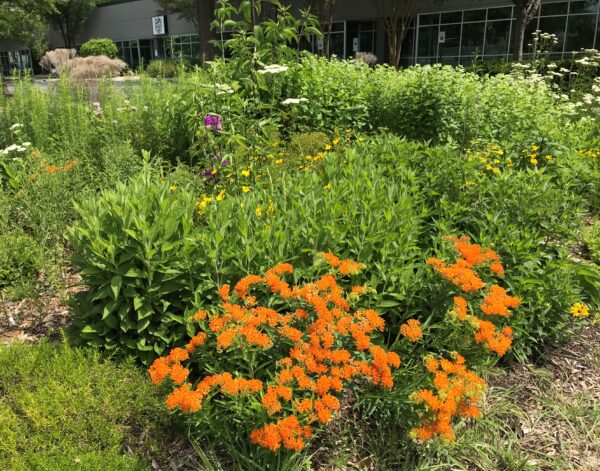
The conventional office park setting at the headquarters of the Virginia Department of Wildlife Resources in Henrico County was transformed when lawn was replaced with a pollinator habitat planting in 2018 and 2019. More than 900 native plants have been installed as of June 2020, featuring more than 40 species, such as Monarda, yarrow, asters, Rudbeckia, Asclepias, pye-weed, Coreopsis, Solidago, Phlox, Pycnanthemum and Zizia. Habitat patches in this type of multi-use area can significantly increase bee abundance and pollinator species diversity.
Instead of clearing fencerows and hedgerows in suburban subdivisions and along rural farm edges, allow native flowering vegetation to fill those areas in, or restore them with a new planting. Plant habitat patches where the landscape is very open, such as common areas in suburban neighborhoods that are routinely mowed, or adjacent to large crop fields in agricultural areas.
Choose native plant species that are highly beneficial to pollinators, such as plants in the Asteraceae family, which includes several genera like Coreopsis, Helianthus (sunflowers), Rudbeckia (coneflowers), Solidago (goldenrods), and Eutrochium (pyeweed), to name a few. Mountain mints (Pycnanthemum) and milkweeds (Asclepias) are also greatly valued by pollinators.
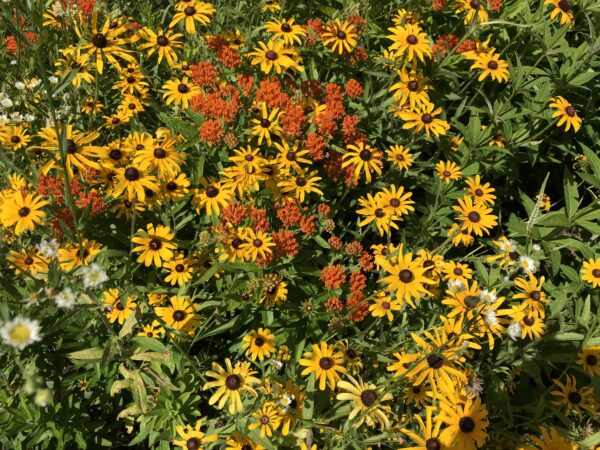
A mix of native perennial black-eyed Susans (Rudbeckia hirta) and butterflyweed (Asclepias tuberosa).
Avoid mowing or disturbing grassy thickets and other low growing, densely vegetated areas, as these provide food resources and possible nest cavities for bumblebees. Similarly, avoid disturbing soil and provide direct access to areas of bare soil, such as on sloped or well-drained sites, because almost 70 percent of native bee species burrow underground to build their nests.
Realize that many native plant species have pithy or hollow stems that are used by bees and other insects as a safe place to lay their eggs in, such as sumac, raspberry, blackberry, elderberry, goldenrod, boxelder and dogwood. If some of the new growth is partially cut back each year, the pithy interior will be better exposed for access. Leave dead or dying trees standing, too, because bees lay their eggs in the tunnels that wood-boring beetle larvae have made in the rotting wood.
In the autumn, leave the fallen tree leaves on the ground and allow the dead stems of plants to remain standing overwinter until at least the middle of May, to provide protection. If you must cut them earlier, bundle them and set aside somewhere else on the property for the bee and insect larvae to complete their life cycle to emerge in spring.
Now is the time to scale up our landscape management practices to include areas that have been conventionally viewed as “waste” spaces, such as roadsides, airports, and utility rights-of-way, too. These large expanses can be transformed into highly productive, dynamic natural plant communities for pollinators and other wildlife, if we just look at them a little differently and with a bit more imagination. By increasing floral diversity and diversifying our landscapes with multi-use habitats, we can start to turn around the declines in pollinator numbers. An investment of time and effort in the short run can yield very high ecological dividends in the long-run.
Consider these ideas food for thought the next time you eat a sweet piece of fruit!
Resources
- Pollinator Partnership – Eco-Region Planting Guides, webinars, educational materials.
- Xerces Society for Invertebrate Conservation – many fact sheets, species profiles, books (Attracting Native Pollinators and Pollinator Conservation Handbook), and a Pollinator Conservation Resource Center. “Bee City USA” is an initiative of Xerces.
- Pollen Specialist Bees of the Eastern United States – web site by Jarrod Fowler and Sam Droege
- Bumblebees of the Eastern United States- ID Guide, USDA Forest Service and The Pollinator Partnership, 2011, 104 pgs, by Colla, Richardson & Williams: https://www.fs.fed.us/wildflowers/pollinators/documents/BumbleBeeGuideEast2011.pdf
- Butterflies of the Mid-Atlantic: A Field Guide, by Robert Blakney and Judy Gallagher Bob Blakney, 2020, ISBN -978-0-578-67780-4, available on Amazon.
- Natural Areas Association – informative webinars, such as 2020 “Conserving Bumblebees” and 2018 “Pollinator Series,” and a quarterly Natural Areas Journal of professional research, which features special issues, such as Managing for Pollinators on Natural Areas and Using Native Plant Materials in Restoration.
- U.S. Fish and Wildlife Service Pollinators home page
- USDA Forest Service Pollinators home page
- Wildlife Habitat Council – Protecting Pollinators web portal – webinars and white papers on managing habitat.
- 5 Pollinator Plants – VA Department of Wildlife Resources webinar with resource sheet, at Virginia Master Naturalist’s “High Five for Nature” page



